Physical Address
304 North Cardinal St.
Dorchester Center, MA 02124
The chest and lungs allow for respiration. The purpose of respiration is to keep the body adequately supplied with oxygen and protected from excess accumulation of carbon dioxide. Respiration involves the movement of air back and forth from the alveoli to the outside environment, gas exchange across the alveolar-pulmonary capillary membranes, and circulatory system transport of oxygen to, and carbon dioxide from, the peripheral tissues. This chapter focuses on the examination of the chest and lungs.
Inspect the chest; front and back and sides, noting thoracic landmarks for:
Size and shape (anteroposterior diameter compared with the lateral diameter)
Symmetry
Color
Superficial venous patterns
Prominence of ribs
Evaluate respirations for:
Rate
Rhythm or pattern
Inspect chest movement with breathing for symmetry and use of accessory muscles.
Note any audible sounds with respiration (e.g., stridor or wheezes).
Palpate the chest for:
Thoracic expansion
Sensations such as crepitus, grating vibrations
Tactile fremitus
Perform direct or indirect percussion on the chest, comparing sides for:
Diaphragmatic excursion
Percussion tone intensity, pitch, duration, and quality
Auscultate the chest with the stethoscope diaphragm, from apex to base, comparing sides for:
Intensity, pitch, duration, and quality of breath sounds
Unexpected breath sounds (crackles, rhonchi, wheezes, friction rubs)
Vocal resonance
The chest, or thorax, is a structure of bone, cartilage, and muscle capable of movement as the lungs expand. It consists anteriorly of the sternum, manubrium, xiphoid process, and costal cartilages; laterally, of the 12 pairs of ribs; and posteriorly, of the 12 thoracic vertebrae ( Figs. 14.1 and 14.2 ). All the ribs are connected to the thoracic vertebrae; the upper seven are attached anteriorly to the sternum by the costal cartilages, and ribs 8, 9, and 10 join with the costal cartilages just above them. Ribs 11 and 12, sometimes referred to as floating ribs, attach posteriorly but not anteriorly. The lateral diameter of the chest generally exceeds the anterior-posterior (AP) diameter in adults.
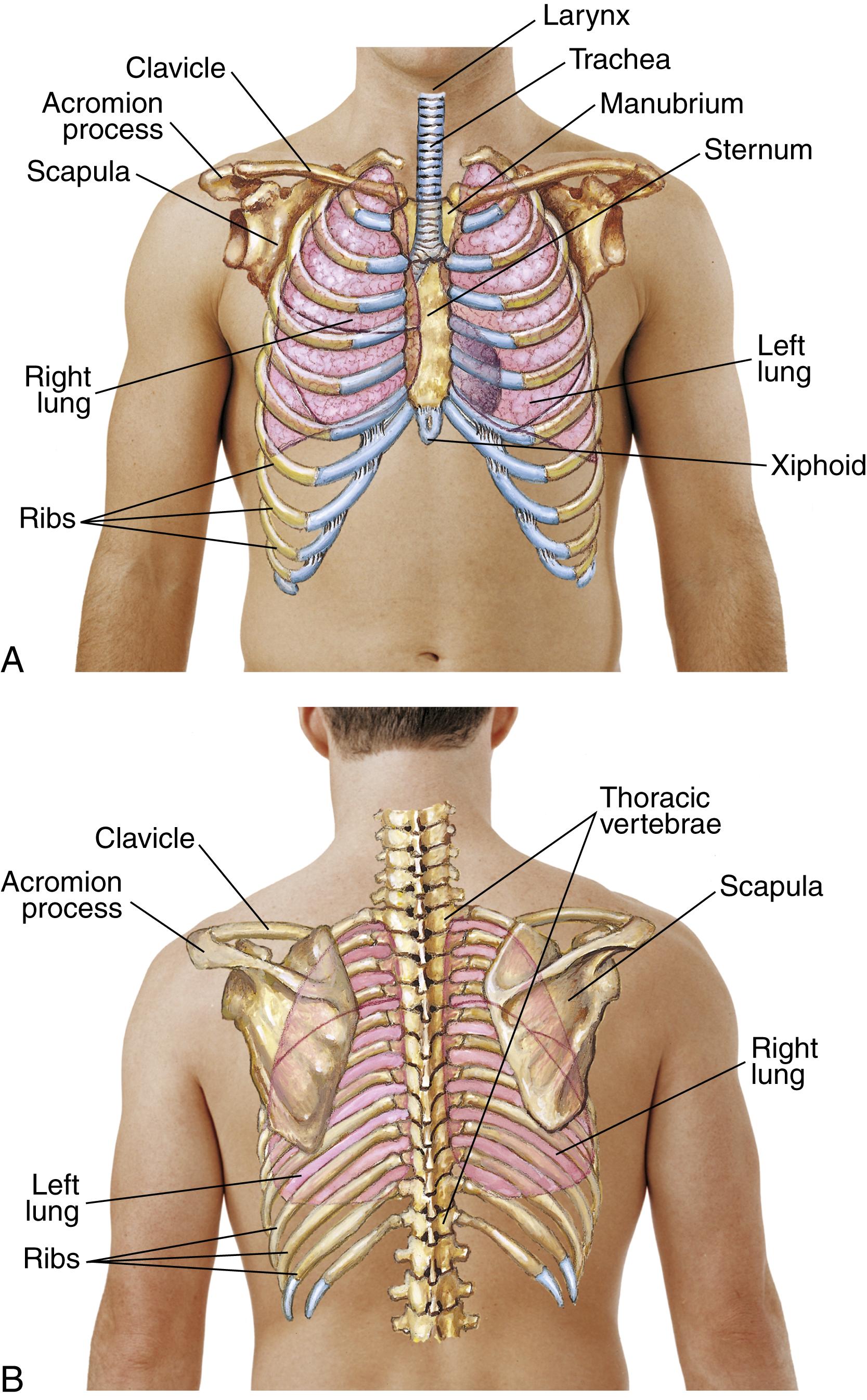
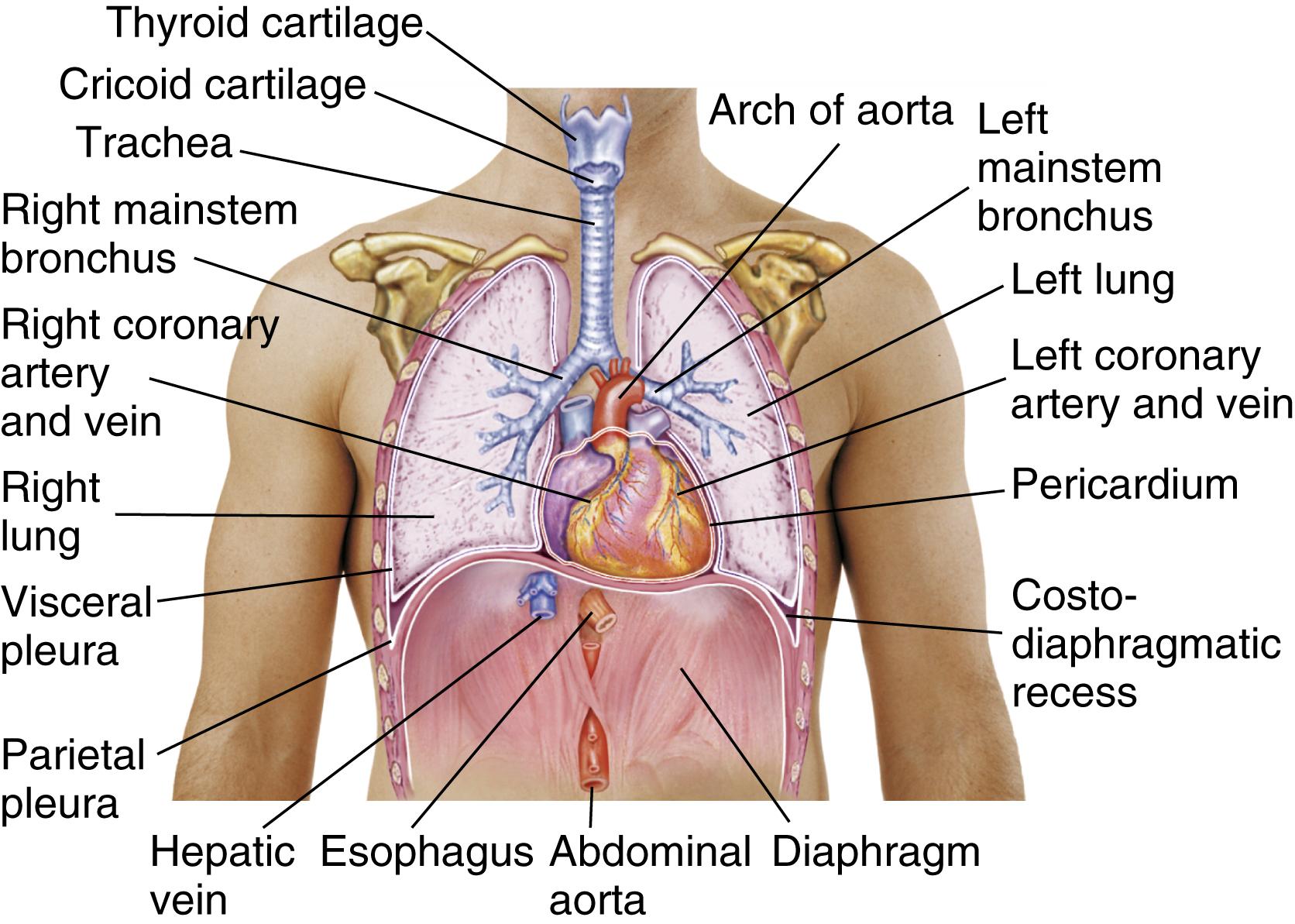
The primary muscles of respiration are the diaphragm and the intercostal muscles. The diaphragm is the dominant muscle. It contracts and moves downward during inspiration, lowering the abdominal contents to increase the intrathoracic space. The external intercostal muscles increase the AP chest diameter during inspiration, and the internal intercostal muscles decrease the lateral diameter during forceful expiration. The sternocleidomastoid and trapezius muscles may also contribute to respiratory movements. These “accessory” muscles are used during exercise or when there is pulmonary compromise ( Fig. 14.3 ).
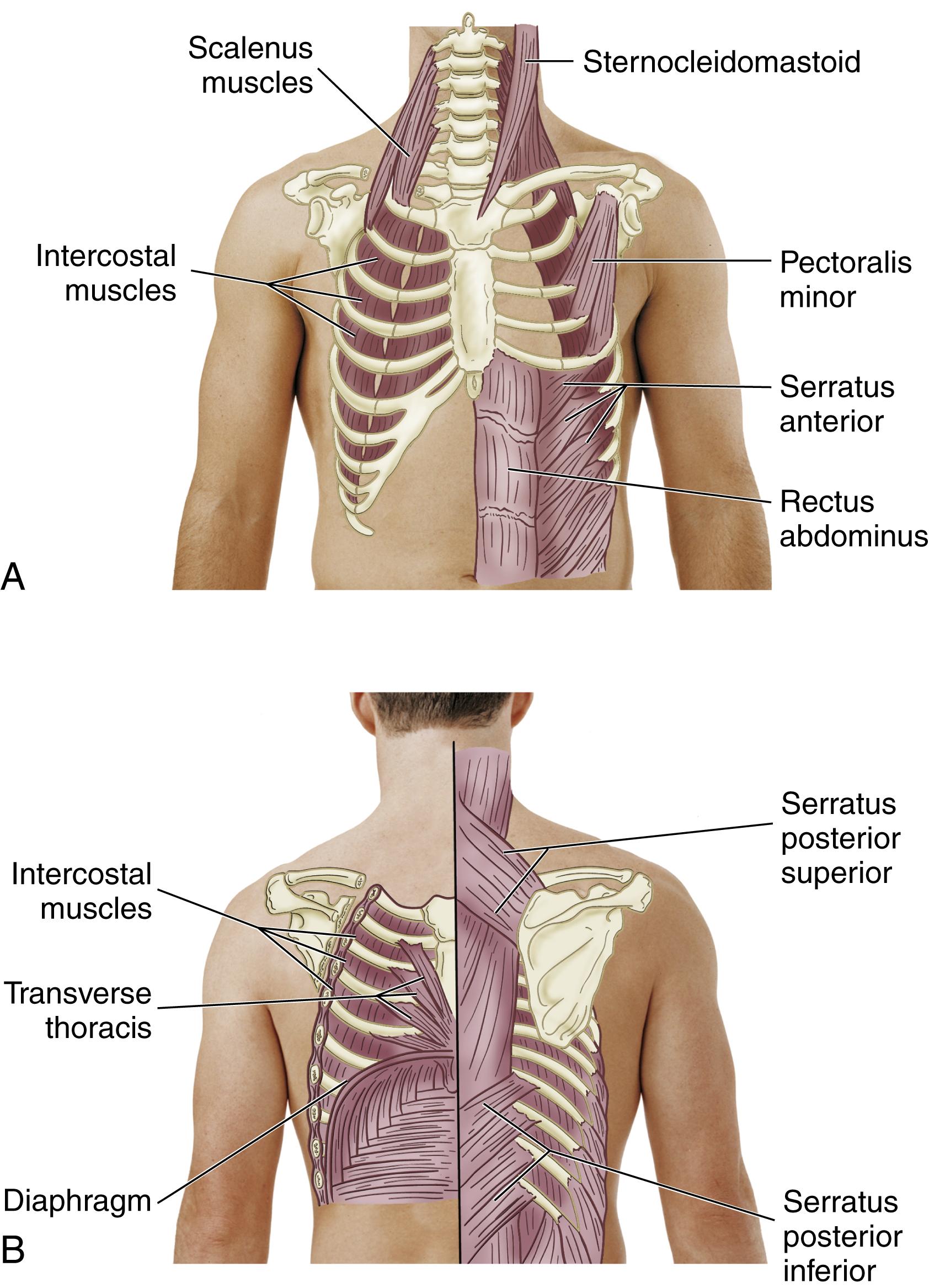
The interior of the chest is divided into three major spaces: the right and left pleural cavities and the mediastinum. The mediastinum, situated between the lungs, contains the heart and major blood vessels. The pleural cavities are lined with serous membranes (parietal and visceral pleurae) that surround the lungs. A tiny space between the parietal and visceral pleura is lined by a small amount of fluid to allow easy lung sliding. The spongy and highly elastic lungs are paired, but not symmetric; the right having three lobes and the left having two ( Fig. 14.4 ). The left upper lobe has an inferior tongue-like projection, the lingula, which is a counterpart of the right middle lobe. Each lung has a major fissure, known as the oblique fissure that divides the upper and lower portions. In addition, a lesser horizontal fissure divides the upper portion of the right lung into the upper and middle lobes at the level of the fifth rib in the axilla and the fourth rib anteriorly. Each lobe consists of blood vessels, lymphatics, nerves, and an alveolar duct connecting with the alveoli; there can be as many as 300 million in an adult. The entire lung is shaped by an elastic subpleural tissue that limits its expansion. Each lung apex is rounded and extends anteriorly about 4 cm above the first rib into the base of the neck in adults. Posteriorly, the apices of the lungs rise to about the level of T1. The lower borders descend on deep inspiration to about T12 and rise on forced expiration to about T9. The base of each lung is broad and concave, resting on the convex surface of the diaphragm. The medial surfaces of the lung are to some extent concave, providing a cradle for the heart.
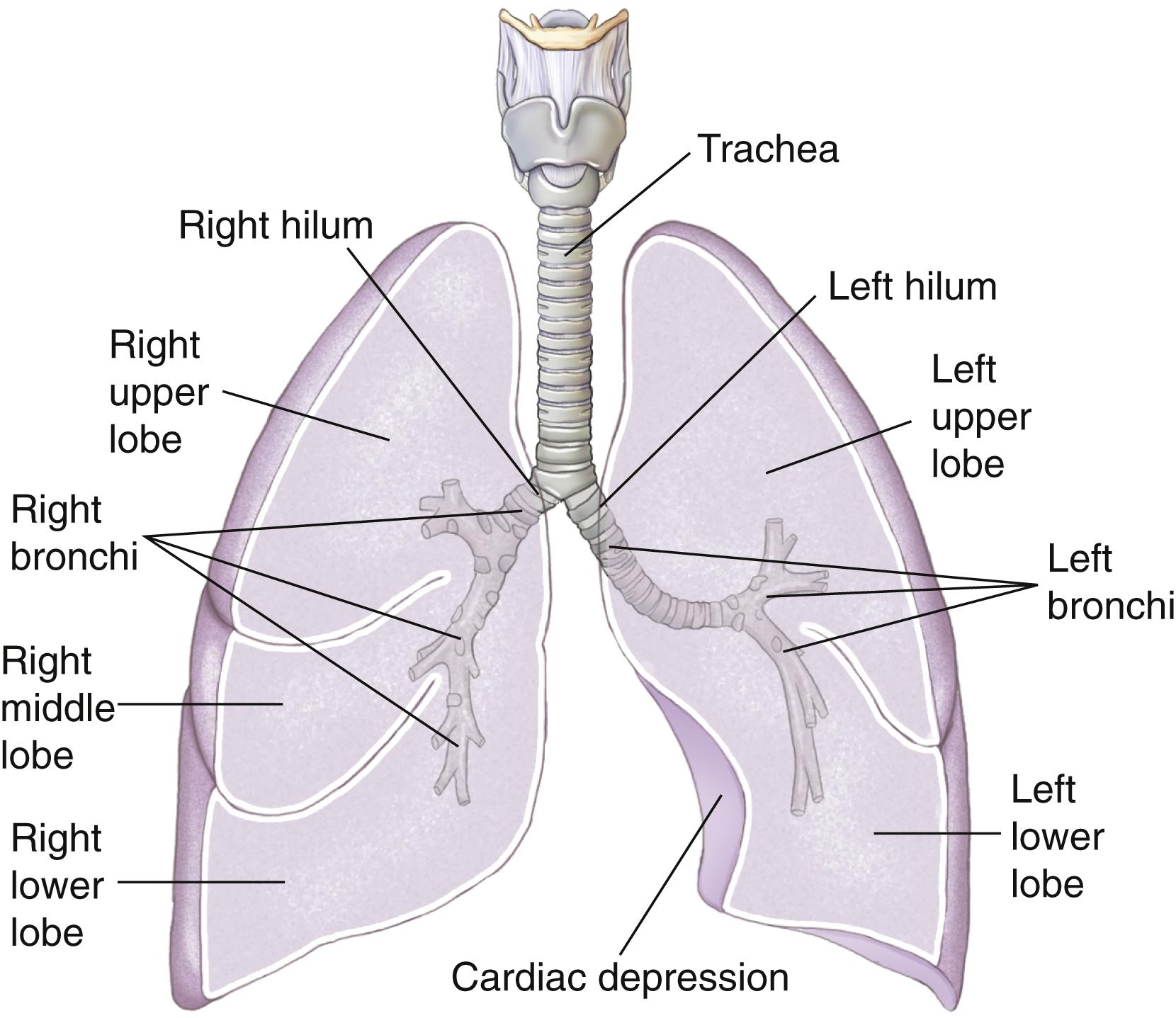
The tracheobronchial tree is a tubular system which provides a pathway along which air is filtered, humidified, and warmed as it moves from the upper airway to the alveoli. The trachea is 10 to 11 cm long and about 2 cm in diameter. It lies anterior to the esophagus and posterior to the isthmus of the thyroid. The trachea divides into the right and left main bronchi at about the level of T4 or T5 and just below the manubriosternal joint ( Box 14.1 ), which is called the sternal angle or angle of Louis.
The right lung may ride higher because of the fullness of the dome of the liver. Except for an inferior lateral triangle, the anterior view on the right is primarily the upper and middle lobes, separated by the horizontal fissure at about the fifth rib in the midaxilla to about the fourth at the sternum; on the left as on the right, the lower lobe is set off by a diagonal fissure stretching from the fifth rib at the axilla to the sixth at the midclavicular line.
Except for the apices, the posterior view is primarily the lower lobe, which extends from about T3 to T10 or T12 during the respiratory cycle.
The lung underlies the area extending from the peak of the axilla to the seventh or eighth rib. The upper lobe is demarcated at about the level of the fifth rib in the midaxillary line and the sixth rib more anteriorly.
The lung underlies the area extending from the peak of the axilla to the seventh or eighth rib. The entire expanse is virtually bisected by the oblique fissure from about the level of the third rib medially to the sixth rib anteriorly.
The right bronchus is wider, shorter, and more vertically placed than the left bronchus (and therefore more susceptible to aspiration of foreign bodies). The main bronchi are divided into three branches on the right and two on the left, each branch supplying one lobe of the lungs. The branches then begin to subdivide into terminal bronchioles and ultimately into respiratory bronchioles.
The bronchial arteries branch from the anterior thoracic aorta and the intercostal arteries, supplying blood to the lung tissue. The bronchial vein is formed at the hilum of the lung, but most of the blood supplied by the bronchial arteries is returned by the pulmonary veins ( Fig. 14.5 ).
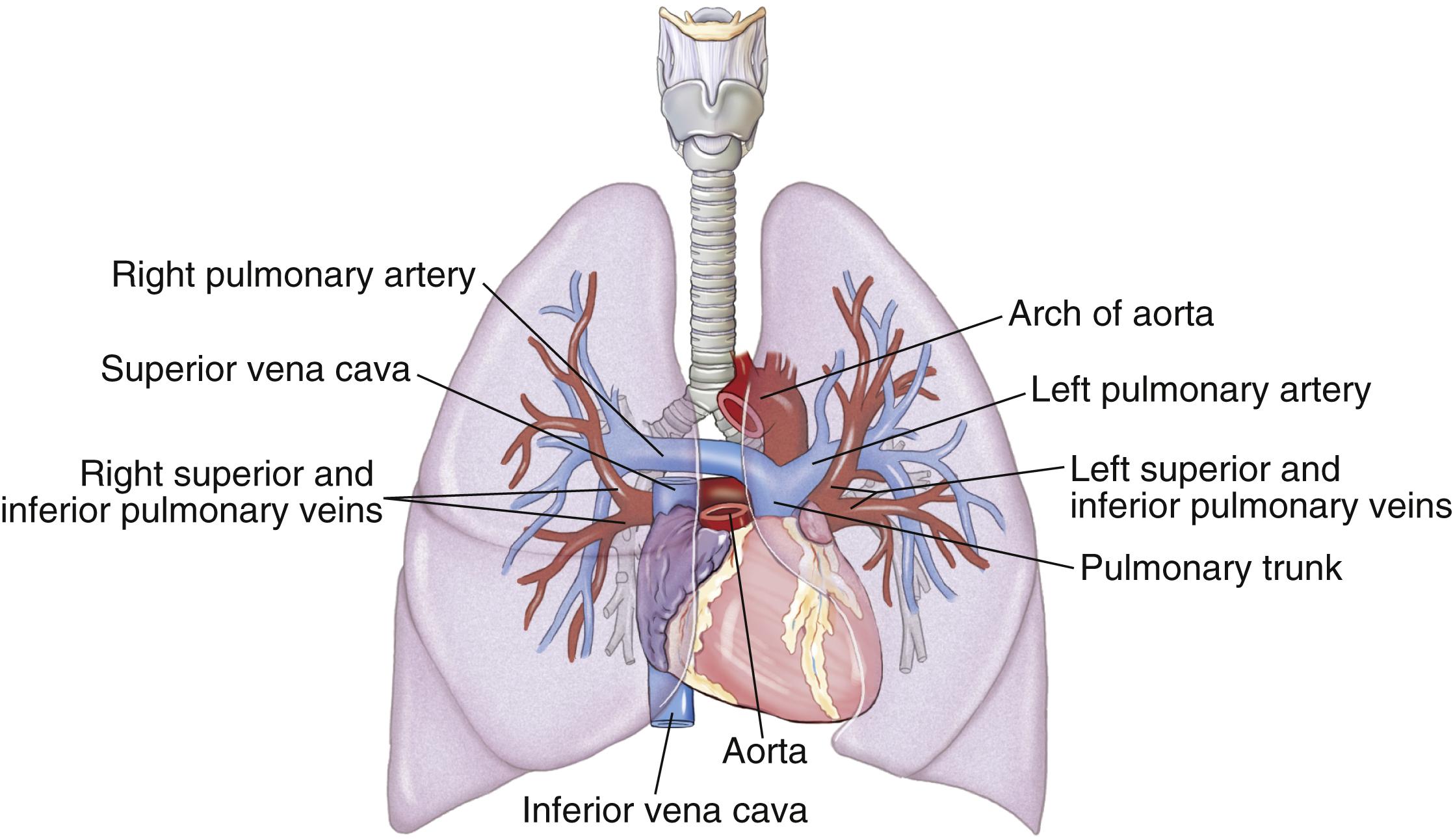
The following topographic markers on the chest are used to describe findings ( Fig. 14.6 ):
The nipples
The manubriosternal junction (angle of Louis). A visible and palpable angulation of the sternum and the point at which the second rib articulates with the sternum. One can count the ribs and intercostal spaces from this point. The number of each intercostal space corresponds to that of the rib immediately above it.
The suprasternal notch. A depression, easily palpable and most often visible at the base of the ventral aspect of the neck, just superior to the manubriosternal junction.
Costal angle. The angle formed by the costal margins at the sternum. It is usually no more than 90 degrees, with the ribs inserted at approximately 45-degree angles.
Vertebra prominens. The spinous process of C7. It can be more readily seen and felt with the patient’s head bent forward. If two prominences are felt, the upper is that of the spinous process of C7, and the lower is that of T1. It is difficult to use this as a guide to counting ribs posteriorly because the spinous processes from T4 down project obliquely, thus overlying the rib below the number of its vertebra.
The clavicles
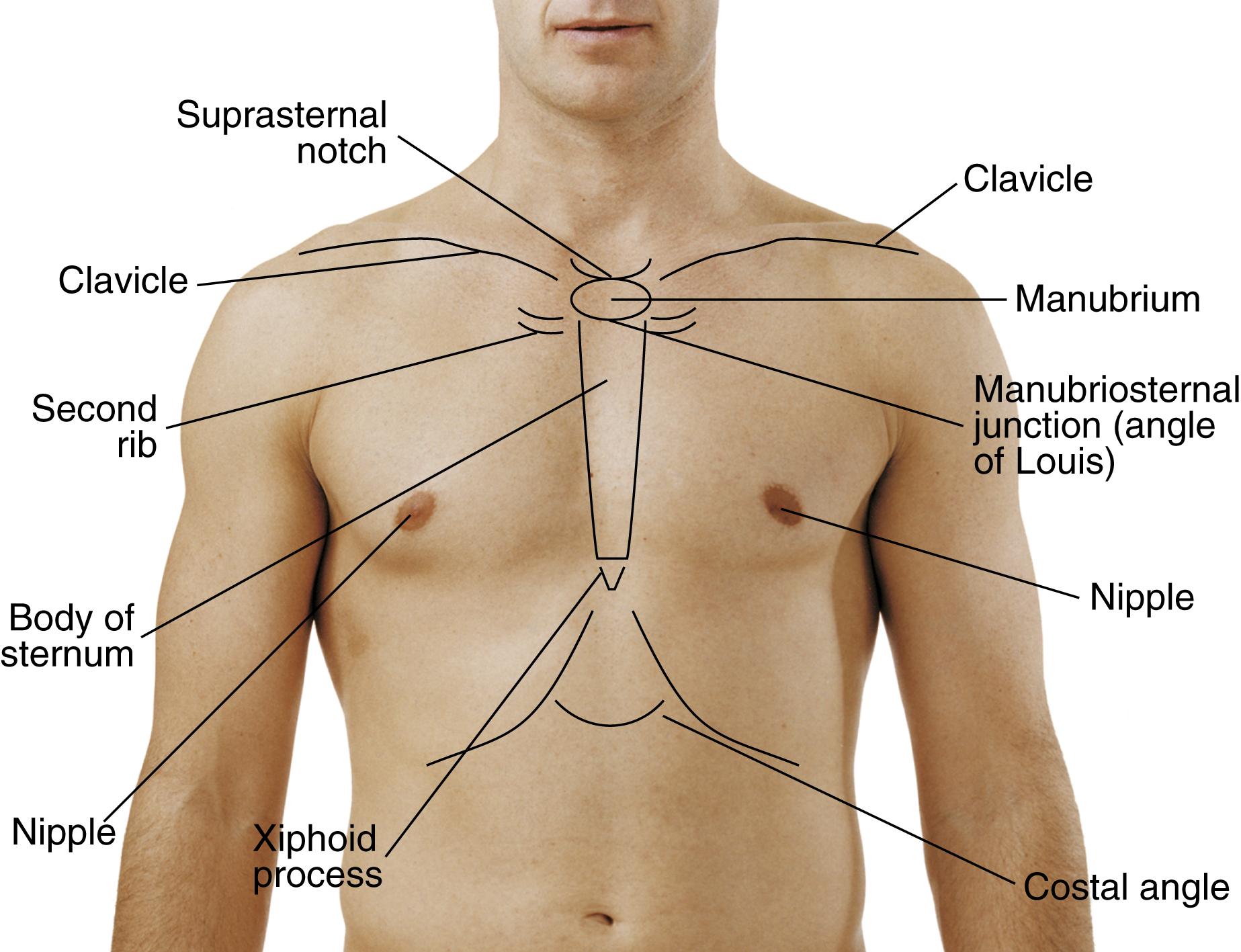
Before birth the lungs contain no air, and the alveoli are collapsed. Fetal gas exchange is mediated by the placenta. Relatively passive respiratory movements occur throughout gestation; they do not open the alveoli or expand the lungs. The lung is not fully grown at birth. The number of alveoli increases at a rapid rate in the first 2 years of life. This slows down by age 8 years.
At birth, the change in respiratory function is rapid and dramatic. After the infant’s initial gasp and cry, the lungs fill with air for the first time. When the umbilical cord is cut shortly thereafter, maternal blood no longer comes through the placenta. At this point blood flows through the infant lungs more vigorously. The pulmonary arteries expand and relax, offering much less resistance than the systemic circulation. This relative decrease in pulmonary pressure most often leads to closure of the heart’s foramen ovale within minutes after birth, and the increased oxygen tension in the arterial blood usually stimulates contraction and closure of the ductus arteriosus (see Clinical Pearl, “Patent Ductus Arteriosus [PDA]”). The pulmonary and systemic circulations adopt their mature configurations, and the lungs are fully integrated for postnatal function.
The chest of the newborn is generally round, the AP diameter approximating the lateral diameter, and the circumference is roughly equal to that of the head until the child is about 2 years old ( Fig. 14.7 ). With growth, the chest assumes adult proportions, with the lateral diameter exceeding the AP diameter.
The heart’s foramen ovale and the ductus arteriosus do not always close so readily. This failure to close is more common in premature infants born before 30 weeks of gestation. A large patent ductus arteriosus, sometimes appreciated as a “machine-like” continuous murmur on auscultation, can lead to left ventricular overload and heart failure.
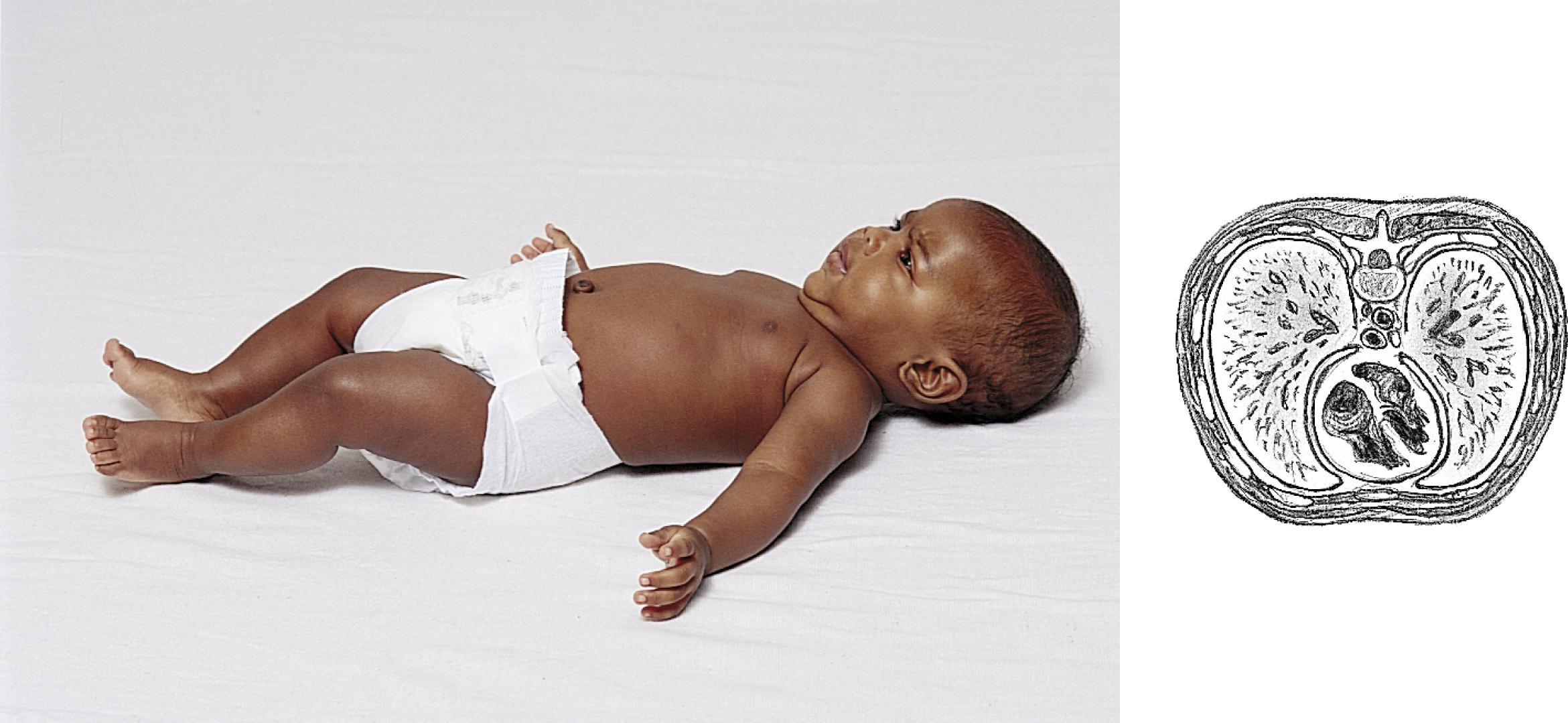
The relatively thin chest wall of the infant and young child makes the bony structure more prominent than in the adult. It is more cartilaginous and yielding, and the xiphoid process is often more prominent and more movable.
Mechanical and biochemical factors, including the enlarged uterus and an increased level of circulating progesterone, interact to create changes in the respiratory function of the pregnant patient. Anatomic changes that occur in the chest as the lower ribs flare include an increase in the lateral diameter of about 2 cm and an increase in the circumference of 5 to 7 cm. The costal angle progressively increases from about 68.5 degrees to approximately 103.5 degrees in later months of pregnancy. The diaphragm at rest rises as much as 4 cm above its usual resting position, yet diaphragmatic movement increases so that the major work of breathing is done by the diaphragm. Minute ventilation increases due to increased tidal volume, although the respiratory rate remains relatively unchanged.
The barrel chest that is seen in many older adults results from loss of muscle strength in the thorax and diaphragm (see Fig. 14.9 ), coupled with the loss of lung resiliency. In addition, skeletal changes of aging tend to emphasize the dorsal curve of the thoracic spine, resulting in an increased AP chest wall diameter leading to a restrictive pattern of lung function. There may also be stiffening and decreased expansion of the chest wall.
With aging, the alveoli become less elastic and relatively more fibrous. The associated loss of some of the interalveolar folds decreases the alveolar surface available for gas exchange. This and the loss of strength in the muscles of respiration result in underventilation of the alveoli in the lower lung fields and a decreased tolerance for exertion. The net result of these changes is a decrease in vital capacity and an increase in residual volume.
Aging mucous membranes tend to become drier and older adults are less able to clear mucus. Retained mucus encourages bacterial growth and predisposes the older adult to respiratory infection.
For each of the symptoms or conditions discussed in this section, targeted topics to include in the history of the present illness are listed. Responses to questions about these topics provide clues for focusing the physical examination and the development of an appropriate diagnostic evaluation. Questions regarding medication use, prescription and over-the-counter preparations, as well as complementary and alternative therapies are relevant for each.
Onset: sudden, gradual
Duration
Nature of cough: dry, moist, wet, hacking, hoarse, barking, whooping, bubbling, productive, nonproductive
Sputum production: duration, frequency, with activity, at certain times of day
Sputum characteristics: amount, color (clear, purulent, blood-tinged, mostly blood), foul odor
Pattern: occasional, regular, paroxysmal; related to time of day, weather, activities (e.g., exercise), talking, deep breaths; change over time
Severity: tires patient, disrupts sleep or conversation, causes chest pain
Associated symptoms: shortness of breath, chest pain or tightness with breathing, fever, nasal congestion, noisy respirations, hoarseness, gagging
Efforts to treat: prescription or nonprescription drugs, vaporizers, lozenges, dry candy, frequent sips of water
Coughs are a common symptom of a respiratory problem. They are usually preceded by a deep inspiration. This is followed by closure of the glottis and contraction of the chest, abdominal, and even the pelvic muscles, and then a sudden, spasmodic expiration, forcing a sudden opening of the glottis. Air and secretions are exhaled. The causes may be related to localized or more general insults at any point in the respiratory tract. Coughs may be voluntary, but they are usually reflexive responses to an irritant such as a foreign body (microscopic or larger), an inflammatory process like asthma, an infectious agent, an underlying problem in the lung parenchyma such as pulmonary fibrosis, or a mass of any sort compressing the respiratory tree. A habit cough can develop after an upper respiratory infection in children and adolescents. They may also be a clue to an anxiety state.
Describe a cough according to its moisture, frequency, regularity, pitch and loudness, quality, and circumstances. The type of cough may offer some clue to the cause. Although a cough may not have a serious cause, do not ignore it.
A moist or productive cough may be caused by infection and can be accompanied by sputum production. A dry or nonproductive cough can have a variety of causes (e.g., cardiac problems, allergies, gastroesophageal reflux with pharyngeal irritation), which may be identified by the quality of its sound.
An acute onset, particularly with fever, suggests infection; in the absence of fever, a foreign body or inhaled irritants can be additional possible causes.
Note whether the cough is seldom or often present. An infrequent cough may result from allergens or environmental insults.
A regular, paroxysmal cough is heard in pertussis. An irregularly occurring cough may have a variety of causes such as: smoking, early congestive heart failure, an inspired foreign body or irritant, or a tumor within or compressing the bronchial tree.
A cough may be loud and high-pitched or quiet and relatively low-pitched.
A cough may occur soon after a person has reclined or assumed an erect position (e.g., with a nasal drip or pooling of secretions in the upper airway).
A dry cough may sound loud and harsh if it is caused by compression of the respiratory tree (as by a tumor) or hoarse if it is caused by croup. Pertussis produces an inspiratory whoop at the end of a paroxysm of coughing in older children and adults.
The production of sputum is generally associated with cough. Sputum in more than small amounts and with any degree of consistency always suggests the presence of disease. When the onset is acute, infection is the most probable cause. A chronic cough implies a significant anatomic change (e.g., tumor, cavitation, or bronchiectasis). The Differential Diagnosis table delineates possible pathologic conditions and their accompanying sputum findings.
| Cause | Possible Sputum Characteristics |
|---|---|
| Bacterial infection | Yellow, green, rust (blood mixed with yellow sputum), clear, or transparent; purulent; blood streaked; sticky |
| Viral infection | Blood-streaked (not common) |
| Chronic infectious disease | All of the above; particularly abundant in the early morning; slight, intermittent blood streaking; occasionally, large amounts of blood∗ |
| Cancer | Slight, persistent, intermittent blood streaking |
| Infarction | Blood clotted; large amounts of blood |
| Tuberculous cavity | Occasional large amounts of blood a |
a Ascertain that the blood is not swallowed from a nosebleed or due to gastric bleeding.
Onset: sudden or gradual; duration; gagging or choking event before onset
Pattern
Position most comfortable, number of pillows used to sleep comfortably
Related to extent of exercise, certain activities, time of day, eating, environmental exposure
Harder to inhale or exhale
Severity: extent of activity limitation, fatigue with breathing, anxiety about getting air
Associated symptoms: pain or discomfort (relationship to specific point in respiratory exertion, location), cough, diaphoresis, ankle edema
Efforts to treat: oxygen use
Dyspnea, or difficult and labored breathing with shortness of breath, is commonly observed with pulmonary or cardiac compromise. A sedentary lifestyle and obesity can cause it in an otherwise well person. In general, dyspnea increases with the severity of the underlying condition. It is important to establish the amount and kind of effort that produces dyspnea:
Is it present even when the patient is resting?
How much walking? On a level surface? Upstairs?
Is it necessary to stop and rest when climbing stairs?
With what other activities of daily life does dyspnea begin? With what level of physical demand?
Other manifestations of respiratory difficulty include the following:
Orthopnea —shortness of breath that begins or increases when the patient lies down; ask whether the patient needs to sleep on more than one pillow and whether that helps.
Paroxysmal nocturnal dyspnea —a sudden onset of shortness of breath after a period of sleep; sitting upright is helpful.
Platypnea —dyspnea increases in the upright posture.
Onset and duration; associated with trauma, coughing, lower respiratory infection, recent anesthesia or surgery, history of thrombosis, prolonged immobilization increasing risk for pulmonary embolism
Associated symptoms: shallow breathing, fever, coughing, anxiety about getting air, radiation of pain to neck or arms
Efforts to treat: heat, splinting, pain medication
Other medications: illicit drug use (e.g., cocaine)
Chest pain does not generally originate in the heart when:
There is a constant achiness that lasts all day.
It does not radiate.
It is made worse by pressing on the chest wall.
It is a fleeting, needle-like jab that lasts only a few seconds.
It is situated in the shoulders or between the shoulder blades in the back.
Thoracic, nasal, and/or pharyngotracheal trauma or surgery, hospitalizations for pulmonary disorders, dates
Use of oxygen or ventilation-assisting devices including continuous or bilevel positive airway pressure machines (CPAP or BiPAP, respectively)
Chronic pulmonary diseases: tuberculosis (date, treatment, compliance), bronchitis, emphysema, bronchiectasis, asthma, cystic fibrosis
Other chronic disorders: cardiac, cancer, blood clotting disorders
Testing: allergy, pulmonary function tests, Interferon Gamma Release Assay (IGRA), tuberculin skin tests, chest imaging
Immunization against Streptococcus pneumoniae, influenza, SARS CoV-2
Tuberculosis
Cystic fibrosis
Emphysema
Allergy, asthma, atopic dermatitis
Malignancy
Bronchiectasis
Bronchitis
Clotting disorders (risk of pulmonary embolism)
Employment: nature of work, extent of physical and emotional effort and stress, crowded work conditions, environmental hazards, exposure to chemicals, animals, vapors, dust, pulmonary irritants (e.g., asbestos), allergens, use of protective masks
Home environment: location, possible allergens, type of heating, use of air-conditioning, humidifier, ventilation, exposure to secondhand tobacco smoke, use of smoke and carbon monoxide detectors in the home
Tobacco use: type of tobacco (cigarettes, e-cigarettes, cigars, pipe, smokeless), duration and amount (Pack years = Number of years of smoking × Number of packs smoked per day), age started, efforts to quit smoking with factors influencing success or failure, the extent of smoking by others at home or at work (secondhand smoking)
Exposure to respiratory infections, influenza, tuberculosis, SARS-CoV-2
Nutritional status: weight loss or obesity
Use of complementary and alternative therapies
Exercise tolerance: amount of exercise, diminished ability to perform up to expectations
Regional or travel exposures (e.g., tuberculosis [TB] infection in India, China, Indonesia, South Africa, and Nigeria; histoplasmosis in southeastern and Midwestern United States; coccidioidomycosis [valley fever] in southwestern United States, Mexico, Central and South America; schistosomiasis in east and southwest Asia, Africa, and the Caribbean)
Hobbies: owning birds or other animals, woodworking or welding
Use of alcohol or illicit drugs (e.g., cocaine, inhaled methamphetamine); see Clinical Pearl, “Pain from Cocaine”
If an adult—especially a young adult—or an adolescent describes severe, acute chest pain, ask about illicit drug use, particularly cocaine. Cocaine can cause tachycardia, hypertension, coronary arterial spasm (with infarction), and pneumothorax (lung collapse), with severe acute chest pain being the common result.
Become a Clinical Tree membership for Full access and enjoy Unlimited articles
If you are a member. Log in here